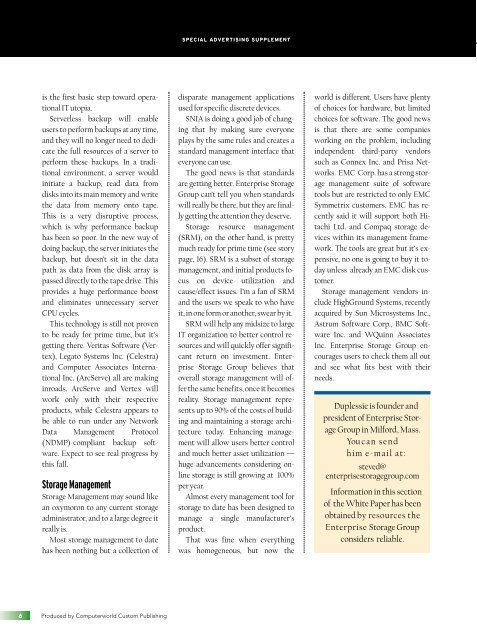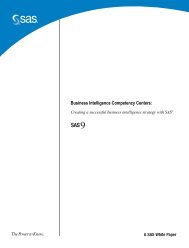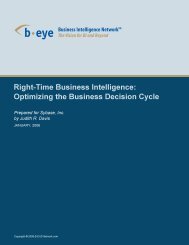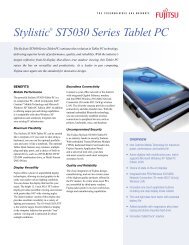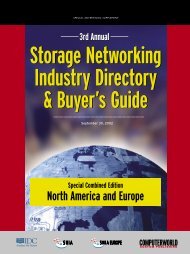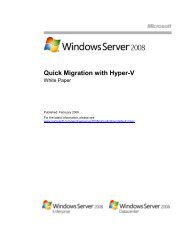Storage Networking - Computerworld
Storage Networking - Computerworld
Storage Networking - Computerworld
Create successful ePaper yourself
Turn your PDF publications into a flip-book with our unique Google optimized e-Paper software.
SPECIAL ADVERTISING SUPPLEMENT<br />
is the first basic step toward operational<br />
IT utopia.<br />
Serverless backup will enable<br />
users to perform backups at any time,<br />
and they will no longer need to dedicate<br />
the full resources of a server to<br />
perform these backups. In a traditional<br />
environment, a server would<br />
initiate a backup, read data from<br />
disks into its main memory and write<br />
the data from memory onto tape.<br />
This is a very disruptive process,<br />
which is why performance backup<br />
has been so poor. In the new way of<br />
doing backup, the server initiates the<br />
backup, but doesn’t sit in the data<br />
path as data from the disk array is<br />
passed directly to the tape drive. This<br />
provides a huge performance boost<br />
and eliminates unnecessary server<br />
CPU cycles.<br />
This technology is still not proven<br />
to be ready for prime time, but it’s<br />
getting there. Veritas Software (Vertex),<br />
Legato Systems Inc. (Celestra)<br />
and Computer Associates International<br />
Inc. (ArcServe) all are making<br />
inroads. ArcServe and Vertex will<br />
work only with their respective<br />
products, while Celestra appears to<br />
be able to run under any Network<br />
Data Management Protocol<br />
(NDMP)-compliant backup software.<br />
Expect to see real progress by<br />
this fall.<br />
<strong>Storage</strong> Management<br />
<strong>Storage</strong> Management may sound like<br />
an oxymoron to any current storage<br />
administrator, and to a large degree it<br />
really is.<br />
Most storage management to date<br />
has been nothing but a collection of<br />
disparate management applications<br />
used for specific discrete devices.<br />
SNIA is doing a good job of changing<br />
that by making sure everyone<br />
plays by the same rules and creates a<br />
standard management interface that<br />
everyone can use.<br />
The good news is that standards<br />
are getting better. Enterprise <strong>Storage</strong><br />
Group can’t tell you when standards<br />
will really be there, but they are finally<br />
getting the attention they deserve.<br />
<strong>Storage</strong> resource management<br />
(SRM), on the other hand, is pretty<br />
much ready for prime time (see story<br />
page, 16). SRM is a subset of storage<br />
management, and initial products focus<br />
on device utilization and<br />
cause/effect issues. I’m a fan of SRM<br />
and the users we speak to who have<br />
it, in one form or another, swear by it.<br />
SRM will help any midsize to large<br />
IT organization to better control resources<br />
and will quickly offer significant<br />
return on investment. Enterprise<br />
<strong>Storage</strong> Group believes that<br />
overall storage management will offer<br />
the same benefits, once it becomes<br />
reality. <strong>Storage</strong> management represents<br />
up to 90% of the costs of building<br />
and maintaining a storage architecture<br />
today. Enhancing management<br />
will allow users better control<br />
and much better asset utilization —<br />
huge advancements considering online<br />
storage is still growing at 100%<br />
per year.<br />
Almost every management tool for<br />
storage to date has been designed to<br />
manage a single manufacturer’s<br />
product.<br />
That was fine when everything<br />
was homogeneous, but now the<br />
world is different. Users have plenty<br />
of choices for hardware, but limited<br />
choices for software. The good news<br />
is that there are some companies<br />
working on the problem, including<br />
independent third-party vendors<br />
such as Connex Inc. and Prisa Networks.<br />
EMC Corp. has a strong storage<br />
management suite of software<br />
tools but are restricted to only EMC<br />
Symmetrix customers. EMC has recently<br />
said it will support both Hitachi<br />
Ltd. and Compaq storage devices<br />
within its management framework.<br />
The tools are great but it’s expensive,<br />
no one is going to buy it today<br />
unless already an EMC disk customer.<br />
<strong>Storage</strong> management vendors include<br />
HighGround Systems, recently<br />
acquired by Sun Microsystems Inc.,<br />
Astrum Software Corp., BMC Software<br />
Inc. and WQuinn Associates<br />
Inc. Enterprise <strong>Storage</strong> Group encourages<br />
users to check them all out<br />
and see what fits best with their<br />
needs.<br />
Duplessie is founder and<br />
president of Enterprise <strong>Storage</strong><br />
Group in Milford, Mass.<br />
You can send<br />
him e-mail at:<br />
steved@<br />
enterprisestoragegroup.com<br />
Information in this section<br />
of the White Paper has been<br />
obtained by resources the<br />
Enterprise <strong>Storage</strong> Group<br />
considers reliable.<br />
6<br />
Produced by <strong>Computerworld</strong> Custom Publishing


